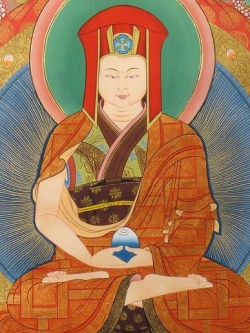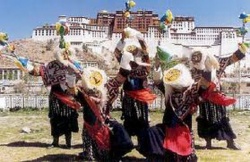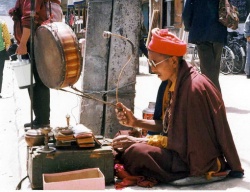Drikung Kagyu
The Drikung Kagyü (Wyl. 'bri gung bka' brgyud) school is one of the Kagyü subschools (more specifically one of the eight Pagdru Kagyü subschools) founded in the twelfth century by Drikung Kyobpa Jikten Sumgön (1143-1217)—one of the eight main disciples of Phagmodrupa Dorje Gyalpo, as well as a disciple of the great Nyingma tertön Nyang Ral Nyima Özer.
In the earlier period of the lineage, the Drikung Kagyü included the Lhapa Kagyü sect, which emerged from one of Jikten Sumgön's disciples named Gyalwa Lhanangpa (1164-1224). This school built the earliest dzongs in Bhutan, but were later eclipsed by the Drukpa Kagyü, and this lineage did not continue for long.
Drikung Kyobpa Jikten Sumgön founded the main seat of the Drikung Kagyü school: the Drikung Til Monastery (Wyl. 'bri gung mthil dgon pa), aka Changchub Ling (Wyl. byang chub gling) in Central Tibet, in 1179.
The Drikung Kagyü school is present today in Tibet, India and Ladakh, and unites both the major Kagyü and Nyingma traditions. This school is famous for its specific phowa practice.
Ringu Tulku Rinpoche writes:
- ...The Drikung Kagyü lineage has a unique teaching called the Sole Intention of the Drikung (Wyl. dgongs gcig), as well as the Essential Point of the Drikung (Wyl. theg chen bstan pa'i snying po), five Mahamudra teachings, and many other collected works and teachings that continue to this day.[1]
The two present heads of the Drikung Kagyü school are the Eighth Drikung Chungtsang Rinpoche (the 36th throne holder of the Drikung Kagyü lineage, who lives in Tibet), and the Seventh Drikung Chetsang Rinpoche (the 37th throne holder of the Drikung Kagyü Lineage, who has established his seat in exile in Dehra Dun, India).
Notes
- ↑ Ringu Tulku, The Ri-me Philosophy of Jamgön Kongtrul the Great (Boston & London: Shambhala Publications, 2006), page 180.
Drikung Kagyu or Drigung Kagyu (Wylie: 'bri-kung bka'-brgyud) is one of the eight "minor" lineages of the Kagyu school of Tibetan Buddhism. "Major" here refers to those Kagyu lineages founded by the immediate disciples of Gampopa (1079-1153) while "minor" refers to all the lineages founded by disciples of Phakmo Drupa (1110-1170), one of the three main disciples of Gampopa.
First monastery
The first and main Drigung Kagyu monastery is Drikung Thil Monastery, founded in 1179 by Drikung Kyobpa Jikten Gönpo Rinchen Päl (1143-1217) approximately 150 kilometers northeast of Lhasa. Aside from the Drigung Valley in Central Tibet, Drikung Kagyu has a strong presence in Nangchen in eastern Tibet, in western Tibet (including Kailash) and Ladakh. Tsari and Lapchi - two important sacred sites for all Tibetan Buddhists - also have a strong Drikung Kagyu presence. Among the so-called "four major and eight minor" Kagyu lineages, Drikung Kagyu is one of four Kagyu lineages that continue to exist as independent institutions (the other three being, Karma Kagyu, Drukpa Kagyu and Taklung Kagyu). Lhanangpa sect
A sub-school of the Drikung was the Lhapa or Lhanangpa sect which was influential in western Bhutan from the arrival of Gyalwa Lhanangpa (b.1164) in 1194 down to the time of Shabdrung Ngawang Namgyal. Members of the Lhapa tradition built some of the earliest dzongs in Bhutan. In 1640 or 1641 members of the Lhapa sect were expelled from Bhutan together with followers of the Nenyingpa school as they had sided with the Tsangpa forces against the Drukpas during their three invasions of Bhutan. Spiritual heads
From the founding of Drikung Thil Monastery in 1179 to the present day, the Drikung Kagyu lineage has been led by a succession of spiritual heads ("throne-holders"). One of the two current heads of the lineage, His Holiness Drikung Kyabgön Chetsang Rinpoche, Könchok Tenzin Kunzang Trinlay Lhundrup (b. 1946), the 37th Drikungpa resides at Drikung Kagyu Institute at Dehra Dun, India. The other head of the Drikung Kagyu Lineage, the 36th Drikungpa, His Holiness Drigkung Kyabgön Chungtsang Rinpoche, Könchok Tenzin Chökyi Nangwa (b. 1942) lives in Lhasa, Tibet. Doctrines
The unique doctrines of Drikung Kagyu as taught by its founder, Jikten Gönpo is preserved in "The Single Intention" (Wylie: dgongs gcig) and "The Essence of Mahāyāna Teachings" (Wylie: theg chen bstan pa'i snying po). The main practices of Drikung Kagyu are “The Five-fold Profound Path of Mahamudrā,” and “The Six Dharmas of Nāropa.” Lineage notes Phowa
The Drikung lineage is popularly known for its development of the practice of Phowa, in which a practitioner learns how to expel his/her consciousness or mindstream through the posterior fontanelle at the top of the skull at the moment of death. One of the Six Yogas of Naropa, this practice is said to aid the practitioner in remaining aware through the death experience, thus aiding one in attaining enlightenment in the Bardo (the state in between death and the next rebirth) or in achieving a birth conducive to the practice of Dharma. Female protector
Another unique feature of the Drikung lineage is its female protector Achi Chokyi Drolma. The great-grandmother of Drigung Kyobpa Jikten Gönpo Rinchen Päl, she prophesied Jikten Gönpo's birth and vowed to protect those in his lineage. She is unusual in that she is both a female protector and an enlightened bodhisattva that can be taken as one's personal yidam in meditation practice. She is depicted either sitting on a horse or standing with a kapala in her left hand and a mirror in her right hand. Achi's practice became so popular that she has been included in other lineages, such as the Karma Kagyu. First Buddhist nun
In 2002 Khenmo Drolma, an American woman, became the first bhikkhuni (a fully ordained Buddhist nun) in the Drikung Kagyu lineage. She is also the first westerner, male or female, to be installed as an abbot in the Drikung Kagyu lineage, having been installed as the abbot of the Vajra Dakini Nunnery (America's first Tibetan Buddhist nunnery, located in Vermont) in 2004.


